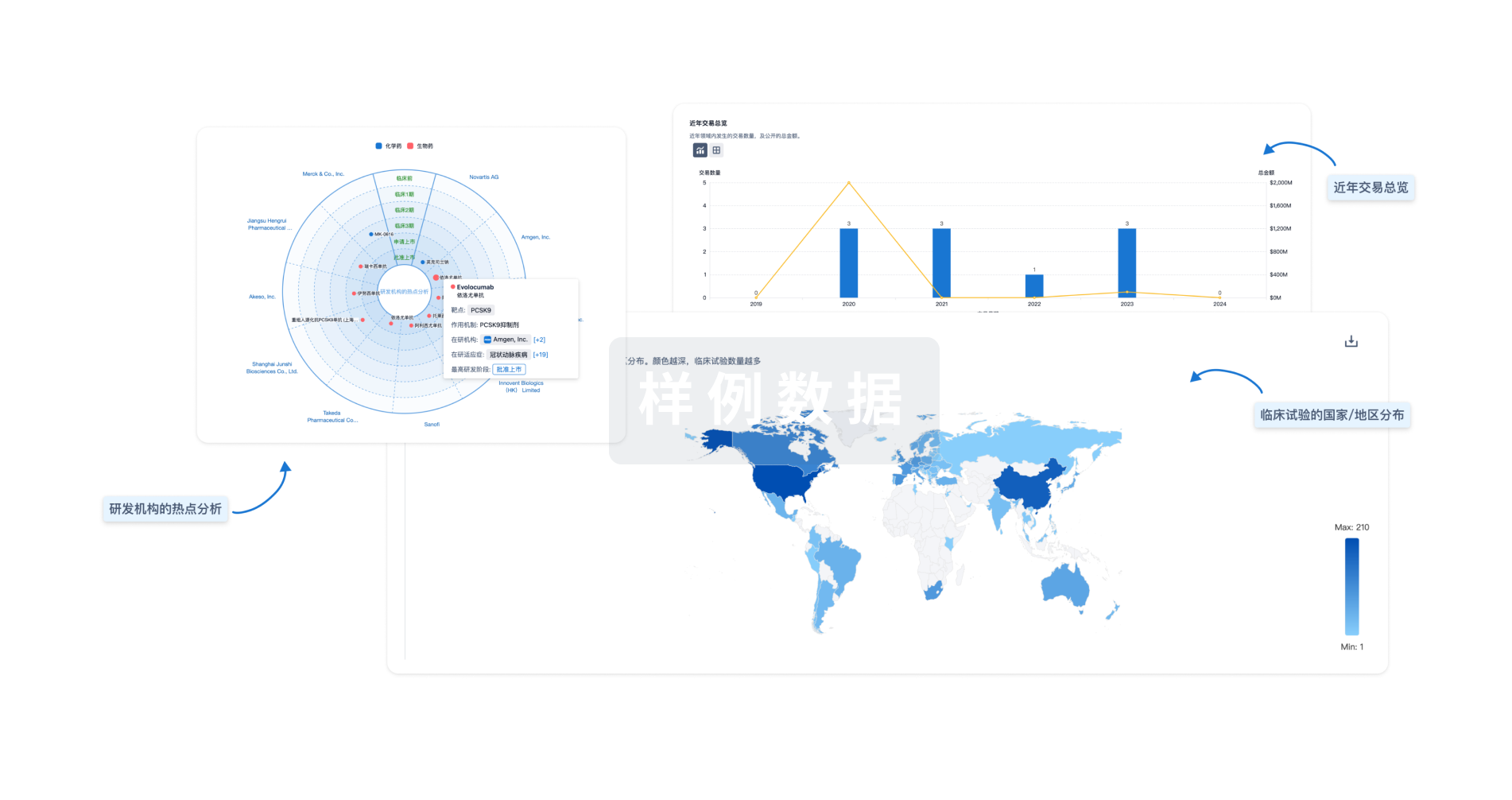预约演示
更新于:2025-05-07
TWIST1
更新于:2025-05-07
基本信息
别名 ACS3、bHLHa38、BPES2 + [10] |
简介 Acts as a transcriptional regulator. Inhibits myogenesis by sequestrating E proteins, inhibiting trans-activation by MEF2, and inhibiting DNA-binding by MYOD1 through physical interaction. This interaction probably involves the basic domains of both proteins. Also represses expression of pro-inflammatory cytokines such as TNFA and IL1B. Regulates cranial suture patterning and fusion. Activates transcription as a heterodimer with E proteins. Regulates gene expression differentially, depending on dimer composition. Homodimers induce expression of FGFR2 and POSTN while heterodimers repress FGFR2 and POSTN expression and induce THBS1 expression. Heterodimerization is also required for osteoblast differentiation. Represses the activity of the circadian transcriptional activator: NPAS2-BMAL1 heterodimer (By similarity). |
关联
100 项与 TWIST1 相关的临床结果
登录后查看更多信息
100 项与 TWIST1 相关的转化医学
登录后查看更多信息
0 项与 TWIST1 相关的专利(医药)
登录后查看更多信息
5,368
项与 TWIST1 相关的文献(医药)2025-12-31·Human Vaccines & Immunotherapeutics
Targeting murine metastatic cancers with cholera toxin A1-adjuvanted peptide vaccines
Article
作者: Kaya, Mustafa ; Paul, Sanchari ; Johnsson, Olivia ; Grauers Wiktorin, Hanna ; Hellstrand, Kristoffer ; Arabpour, Mohammad ; Törnell, Andreas ; Martner, Anna
2025-07-01·Life Sciences
Transcriptional and post-translational mechanisms of ECM remodeling in rotator cuff tendons under hyperlipidemic conditions
Article
作者: Rajalekshmi, Resmi ; Agrawal, Devendra K
2025-06-01·Molecular Phylogenetics and Evolution
Exploring the evolution of anaerobes within ciliate class Prostomatea by transcriptomics
Article
作者: Chen, Miaoying ; Pan, Xuming ; Yi, Zhenzhen ; Xu, Jiahui ; Su, Hua ; Shen, Zhuo ; Hao, Tingting
46
项与 TWIST1 相关的新闻(医药)2025-04-20
DRUGAI疾病发生和进展的特异性研究中,识别调控转录因子(TRs)仍具有挑战性,这些因子通过调控元件和表观基因组信号控制基因表达。大规模多组学表观基因组数据的引入,为解析调控元件及其调控因子的复杂模式提供了可能。研究人员在此提出TRAPT,一个多模态深度学习框架,可通过学习和整合靶基因的顺式调控元件及全基因组结合位点的调控潜能,推断转录因子的活性。在570个与TR相关的数据集上,TRAPT在预测转录因子,尤其是协同因子和染色质调控因子方面优于现有方法。此外,该方法成功识别出与疾病、遗传变异、细胞命运决策及组织相关的关键转录因子,展现了基于表观组数据识别TRs的全新视角。基因表达调控由多种上游转录调控因子(TRs)共同驱动,包括转录因子(TFs)、协同因子(TcoFs)和染色质调控因子(CRs),它们介导启动子与远端增强子的信号传递。异常的基因表达常与疾病发生密切相关,因此识别关键调控因子对于理解疾病机制至关重要。随着 ChIP-seq 和 ATAC-seq 等技术的发展,顺式与反式调控图谱得以清晰描绘。TRs 在染色质开放性和组蛋白修饰等表观信息的共同作用下,展现出细胞特异性的调控活性。此外,大量研究表明 TFs 可通过结合启动子或增强子等顺式调控序列,调节靶基因表达。鉴于基因调控机制的复杂性,研究人员亟需利用大规模表观基因组数据,全面捕捉基因上游的协同调控特征,以提升 TRs 的预测能力。高通量测序技术的快速发展使 ATAC-seq、DNase-seq 和 ChIP-seq 等数据迅速积累。然而,不同来源的数据存在噪声干扰、批次效应及冗余等问题,增加了整合与表示学习的难度。目前已有多种方法尝试通过功能基因集推断上游 TRs,如 Enrichr、ChEA3、Lisa 等,但这些方法大多基于统计富集分析,未能充分利用顺式调控元件(CREs)的详细信息。而CREs是 TF 功能的核心,缺乏这部分信息将限制调控因子的准确预测。一些方法虽引入 CRE 数据,但仅局限于与输入基因集相关的区域,无法覆盖全基因组调控图谱。此外,TRs 往往倾向于结合在活跃染色质区域,表现出结合偏好(TRBP),这类偏好尚未被现有方法充分建模。更重要的是,当前大多数方法仅限于通过基因集推断上游调控因子,缺乏对其全基因组结合位点的推理能力,因此急需能够全面整合CRE与结合位点的预测框架。多组学表观数据的整合也存在诸多挑战,例如跨模态干扰与非线性关系。现有方法多基于传统回归模型,未能有效处理跨模态间的复杂关系。深度学习技术在多个生物学任务中已展现出强大表现,其关键在于高质量数据的采集与建模。研究人员此前构建了多个表观调控数据库,如 TcoFBase、CRdb、TFTG、SEdb 和 ATACdb,系统汇聚了大量 TRs、增强子与染色质开放性信息,构建了当前最全面的表观特征资源库。结合这些数据资源与先进深度学习方法,为深入解析表观调控网络提供了前所未有的可能。本研究中,研究人员提出了一个数据驱动的深度学习框架——TRAPT,融合多阶段学习结构,通过知识蒸馏和图卷积神经网络整合表观特征,联合建模靶基因的顺式调控元件信号与全基因组结合位点,优化 TR 活性表示,并识别上下文特异的关键调控因子。在570个 TR 敲除数据集上进行评估,TRAPT 在预测 TFs、TcoFs 和 CRs 方面均优于现有方法。进一步,TRAPT 成功识别出阿尔茨海默病中的关键因子(如 REST),并在细胞发育与组织数据中准确预测了控制细胞命运与组织特异性的调控因子。结果TRAPT 方法概述TRAPT 是一个整合多组学信息的预测框架,旨在根据输入的感兴趣基因集推断转录调控因子(TRs)的活性。简而言之,该模型以基因集为输入,输出每个TR的活性评分。TRAPT 采用多阶段融合策略,分别处理来自全基因组结合位点的下游调控潜能(D-RP)以及源自顺式调控元件的上游调控潜能(U-RP),从而解决TR结合偏好(TRBP)和顺式调控信息缺失(ICCP)的问题。TRAPT 的流程主要包括四个步骤:计算表观调控潜能(Epi-RP)与转录因子调控潜能(TR-RP):研究人员收集了超过 20,000 份表观基因组数据,包括 ATAC-seq、H3K27ac 和 TR ChIP-seq 数据,并进行预处理后,计算每个基因的调控潜能。通过对表观组数据统一加权衰减,并对TRs采用上下文特异的衰减策略,分别得到 Epi-RP 和 TR-RP,用于后续建模。预测 TR 的下游调控潜能(D-RP):该步骤旨在将 Epi-RP 与 TR-RP 融合,构建 TR 与表观样本之间的异构网络(ERN)。研究人员采用 k 近邻算法建立网络,并使用条件变分自编码器(CVAE)与图变分自编码器(VGAE)构建的知识蒸馏模型(D-RP模型)进行优化。教师模型学习多模态嵌入,学生模型学习统一、低噪声表示。该机制提升了模型对跨模态数据的鲁棒性,输出为 D-RP 矩阵。预测查询基因集的上游调控潜能(U-RP):研究人员设计了另一个知识蒸馏模型(U-RP模型),以Epi-RP和输入基因集为基础,选出关键的表观组样本并推断其调控作用。学生模型在教师模型提供的“软标签”指导下,通过稀疏组套索(SGL)方法引入组内与组间稀疏性,实现对非冗余、非线性组合样本的精准筛选。输出为U-RP向量,包含与查询基因相关的染色质开放性(ATAC)与活性状态(H3K27ac)信息。整合 D-RP 和 U-RP 推断 TR 活性:将归一化后的 TR-RP 和 D-RP 矩阵逐元素相加,再与 U-RP 向量逐元素相乘,获得整合调控潜能(I-RP)。随后,使用 ROC 曲线下面积(AUC)衡量 TR 与基因集的相关性,并合并两种路径得到最终的 TR 活性评分。综上,TRAPT 融合了 TR 的全基因组结合潜能与靶基因顺式调控潜能,能够在上下文特异的基础上,高效识别调控输入基因集的关键 TRs。TRAPT 在基准数据集上表现优越研究人员采用“目标TR排序分数”作为主要评估指标,衡量算法根据基因集预测对应调控因子排名的能力。例如,在 GATA6 敲除实验中,若GATA6本身的排名靠前,则说明预测性能较好。为全面评估TRAPT,研究人员整合了来自 KnockTF 数据库的570个转录因子敲除/敲低数据集,经过质量控制和差异表达分析,从每个RNA-seq数据集中筛选出上调与下调基因,作为TRAPT的输入,并对预测结果中的目标TR排名进行评估。研究人员将 TRAPT 与多个主流方法进行了比较,包括以基因集为输入的 Lisa、BART、i-cisTarget 及富集分析方法 ChEA3。评估标准包括命中前10或前N个目标TR的数量,以及整体TR识别表现。结果显示,TRAPT 在识别前10个TR方面比表现第二好的方法(Lisa)高出13%;相较 i-cisTarget 的提升更超过200%。TRAPT 的 AUC 达到 0.643,明显优于其他方法;其平均倒数排名(MRR)为 0.067,也分别比 Lisa 和 BART 提高了18% 和 76%。这些结果表明 TRAPT 在预测 TR 活性方面具备显著优势。不同于以往方法主要集中在 TF 的预测,TRAPT 引入高质量的转录协同因子(TcoFs)与染色质调控因子(CRs)数据,使得其具备更全面的调控因子预测能力。在 TF、TcoF 与 CR 三类子集中,TRAPT 均展现出领先性能。特别是在 TcoF 与 CR 的预测中,Lisa 的表现显著下降,而 TRAPT 仍保持优异结果,说明其在多类调控因子预测上的全面性得益于多阶段融合策略与丰富的数据支持。为了验证 TRAPT 的优势并非仅因数据覆盖度更高,研究人员将 Lisa 和 BART 与 TRAPT 一同使用 Cistrome 数据库的背景数据,并以 KnockTF 数据集为标准重新评估。结果显示,即便在相同背景数据下,TRAPT 的整体表现仍优于 Lisa(提升 30%)和 BART(提升 85.7%)。进一步评估显示,TRAPT 在 TF、CR 与 TcoF 三个类别中的AUC均高于对比方法,其中对 CR 的预测性能甚至比 Lisa 高出 198.4%。此外,研究人员还比较了不同蛋白家族在不同类型数据(如 TR 敲除数据 vs. TR 结合数据)下的预测表现,发现部分家族(如 CP2、RXR-like)在敲除数据上表现更佳,而其他家族(如 zf-C2H2、IRF、THR-like)在结合数据中效果更好。这可能源于转录因子敲除后引发的二级转录调控效应。最后,针对大规模数据整合可能带来的运算时间问题,研究人员比较了 TRAPT 与 Lisa、BART 的运行时间。结果显示,TRAPT 不仅性能优越,还具有更快的运行效率,尤其在单个TR活性预测任务中显著快于其他方法。多阶段融合策略显著提升转录调控因子预测性能为验证多阶段融合策略对 TR 预测的提升效果,研究人员进行了系统的消融实验。TRAPT 中的 U-RP 模型用于模拟靶基因顺式调控元件的调控潜能,捕捉其上下文特异性的表观状态。当移除该模块时,整体性能显著下降,说明其有效表征了输入基因的表观调控特征。D-RP 模型则预测TR在不同条件下对基因组的结合偏好,考虑了调控元件的活性。去除该模块同样导致性能下降,进一步表明结合元件活性对于TR功能建模具有重要意义。此外,研究人员还通过计算TR与远端增强子结合比例,构建了特异性调控潜能模型。去除该TR特异性建模也导致性能下降,显示其对识别不同调控模式具有重要作用。TRAPT 融合多种表观组学特征以预测最终的TR活性。对不同模块性能的深入分析发现,TRAPT-H3K27ac 模型对上调基因集预测更优,而TRAPT-ATAC 模型则更适合下调基因集。当移除所有表观模块,仅保留启动子区域模型时,预测性能显著下降。进一步逐步移除表观模块,整体性能也持续下降,表明TRAPT在多模态特征融合方面具有良好稳定性。知识蒸馏机制在TRAPT中也发挥了重要作用。相比未使用知识蒸馏的模型(NKD),使用蒸馏策略(KD)在 KnockTF 数据集上提升了5.4%,在 Lisa 数据集上提升了7.9%。在top-10 TR预测任务中,KD模型的AUC高出8个百分点,表现显著优于NKD。模型在训练与验证集上的损失值快速下降,且蒸馏策略下 D-RP 学生模型收敛更快、准确率更高,表明知识蒸馏提升了模型稳定性且未引入过拟合。在 D-RP 模型中,研究人员利用 kNN 算法构建TR与表观组学样本之间的连接网络,并以连接恢复任务评估其预测能力。实验结果显示,在验证集中,教师与学生网络的损失值迅速下降,最终在测试集上分别达到 auROC 0.81 与 auPRC 0.84 的表现。即便在最多屏蔽15%边的情况下,模型恢复能力依然稳定,AP 值保持在0.8以上,表明其对缺失连接具有良好的鲁棒性。U-RP 模型的目标是基于基因集与 Epi-RP 矩阵预测顺式调控图谱。训练过程中,其损失值也稳定下降。为解决冗余样本筛选问题,研究人员分析了在不同数量样本下的性能变化。当特征数达到10时,性能提升趋于平稳,与已有研究一致。最后,研究人员比较了TRAPT在预测上调与下调基因集时的表现,发现其对下调基因集的预测更为准确。这一现象也支持了激活因子多于抑制因子的生物学观察。多数 TR 仅具有单一功能,部分如 CTCF、NANOG、FOXA1、ESR1 则同时具有激活与抑制作用。综上,TRAPT 能够准确识别激活型、抑制型及双功能调控因子。TRAPT 在 ESR1 敲低实验中准确识别关键转录调控因子ESR1 是乳腺癌 ER 阳性亚型中的关键转录因子,调控多种与疾病风险相关的下游基因表达。为验证 TRAPT 在疾病背景下识别关键 TRs 的能力,研究人员将其应用于 MCF7 ER+ 乳腺癌细胞中 siRNA 敲低 ESR1 后得到的差异表达基因集。TRAPT 准确预测到 ESR1 在下调基因集中排名第1,上调基因集中排名第17,反映出其在乳腺癌中兼具激活与抑制功能。TRAPT 还识别出与 ESR1 密切相关的多个转录因子、协同因子与染色质调控因子,包括 FOXA1、EP300 和 MED1。其中,GATA3 是哺乳腺细胞命运的重要调控因子,FOXA1 通过调节染色质可及性影响乳腺癌发生发展,EP300 可乙酰化 ESR1,增强其靶基因表达。此外,从 STRING 数据库得到的这些高排名 TRs 之间具有频繁的相互作用;TCGA 和 GTEx 数据的共表达分析也显示 GATA3、FOXA1 和 ESR1 三者之间具有显著相关性,进一步验证了 TRAPT 的准确性。研究人员还分析了 D-RP 分数对 TR 活性的刻画能力。将 ESR1 及其相关 TR 的 D-RP 分数分别作用于目标基因与背景基因集,结果显示其在目标基因集中显著更高(如 ESR1 在 ATAC 和 H3K27ac 模块下的 p 值分别为 3.3e-38 和 8.6e-34)。随着预测排名下降,TR 的重要性逐渐减弱,而排名最末的 HDGF 表现出明显较低的调控潜能,说明 D-RP 能有效区分关键 TR 与非关键 TR。此外,研究人员构建了高低 I-RP 分数的 TR 活性曲线,发现高分组的 TRs 对基因集的信号更强,进一步支持 TRAPT 的预测准确性。考虑到 ESR1 可结合远端增强子(如 ERSE),TRAPT 利用其专属的调控潜能模型对远端调控进行建模。研究人员将增强子分为近端与远端两类,发现预测出的 TR 更倾向于在目标基因附近的增强子区域中结合,而非背景区域。GATA3 和 FOXA1 明显偏好近端区域,ESR1 与 EP300 则未表现出显著偏好。最后,研究人员可视化了 ESR1、GATA3、FOXA1、EP300 和 HDGF 附近的差异表达基因轨迹,发现前四者在目标区域均表现出明显的结合峰,而 HDGF 则缺乏这种特征。这一系列结果进一步验证了 TRAPT 在预测 TF、协同因子及染色质调控因子方面的可靠性和解释力。预测阿尔茨海默病相关的关键调控因子转录因子(TF)结合位点上的遗传变异可能改变其结合能力,进而影响基因表达和细胞功能。为验证 TRAPT 在疾病研究中的适用性,研究人员将其应用于阿尔茨海默病(AD)GWAS 后分析。研究人员利用 MAGMA 工具从 GWAS 汇总数据中获得 AD 相关基因集作为 TRAPT 的输入,并结合细致的精细定位与结合位点共定位分析,识别出一系列被致病变异影响的关键 TRs。在欧洲人群 GWAS 数据的基础上,TRAPT 所预测的前 25 个 TRs 中,有 68.2% 的结合 SNP 来自 AD 因果变异(p = 2.5e-12),而排名后 25 个 TR 的比例显著更低,表明排名越高的 TR 越可能与 AD 密切相关。进一步分析发现,TRAPT 排名前列的 TRs(如 SPI1、RELA、REST)在致病变异上的结合强度高于背景变异。例如,SPI1 与 71 个致病变异发生交集,远高于背景(p = 3.6e-4)。GSEA 统计检验也证实前列 TRs 与因果位点显著富集。通过 FINEMAP 打分和功能注释,研究人员发现 rs10119 为评分最高的 AD 相关变异,与 APOE、TOMM40 和 APOC1 等关键基因相邻,且被多个预测的 TR 所结合(如 REST)。rs10119 位于染色质环结构的关键节点,多个已知 AD 相关的 TR(SPI1、STAT1、HDAC2 等)都在其上下游区域结合,进一步强化了其功能重要性。此外,在 AD 相关的 H3K27ac ChIP-seq 数据中,TRAPT 所选样本的调控区域与 rs10119 高度重叠,说明模型即便不依赖 AD 特异的表观数据,也能选择出具有相似信号的替代样本。识别驱动细胞命运和组织特异性的关键调控因子转录调控因子在细胞命运决定、分化过程和组织特性维持中起关键作用。研究人员进一步将 TRAPT 应用于单细胞转录组数据,以识别血液细胞分化路径中的驱动因子。在人类造血干细胞 scRNA-seq 数据中,TRAPT 成功识别了 42 个潜在关键 TR,其中 29 个已知与造血发育密切相关,10 个在不同分化亚群中呈现显著差异表达。此外,部分 TRs 出现在多个谱系中(如 EP300、SMAD1、SPI1、TAL1),另一些如 STAT4 和 TCF4 则特异性分布于 NK 和 pDC 谱系,具有已知的调控功能。在另一个人类胚胎干细胞数据集中,TRAPT 同样成功识别出 GATA3、TFAP2A、GATA2 等在滋养层细胞中活性增强的 TRs,以及 GATA6、SMAD2 和 EOMES 等在内胚层细胞中活跃的 TRs,这些结果均与既往研究一致。对 GTEx 项目中30种正常人组织的 RNA-seq 数据分析中,TRAPT 利用每个组织的差异表达基因成功预测出特异性调控因子。例如,心脏组织中识别出 MED1、TBX5、GATA4;前列腺中识别出 AR、FOXA1、HOXB13;而乳腺与脂肪组织共享了 PPARG 和 CEBPA。在对预测结果进行层次聚类时,乳腺与脂肪组织、女性生殖系统相关组织(如子宫、卵巢、宫颈)因细胞组成相似而聚类在一起,进一步验证了模型的生物学合理性。讨论转录调控因子(TRs)在调控基因表达、维持细胞稳态和引导发育过程中起着核心作用。TR 介导的转录程序通常具有独特的表观基因组图谱,并在细胞状态变化与疾病发生中充当“开关”。然而,当前针对特定基因集(如差异表达基因、单细胞标记基因)准确预测其上游TR仍面临挑战,主要受限于缺乏覆盖多样细胞类型的TR表观数据。为解决这一问题,研究人员提出了深度学习框架 TRAPT,通过双阶段知识蒸馏提取调控元件的活性表示,整合超过 20,000 个大规模表观基因组样本与全面的TR背景知识库,精准预测上下文依赖的关键TR。在570个TR敲除/敲低数据集上,TRAPT 相较 Lisa、BART、i-cisTarget、ChEA3 等主流方法表现出显著性能提升,成功识别出与疾病、遗传变异、细胞命运与组织特异性密切相关的核心TRs。当前TR预测方法主要分为两类:一类是基于基因集富集分析的方法,如 Enrichr、TFEA.ChIP、ChEA3 和 MAGIC,依赖统计检验评估TR的重要性,但无法模拟TR与顺式元件的真实结合;另一类如 i-cisTarget、BART 和 Lisa,通过模拟TR结合预测活性,但未能充分考虑TR的结合偏好。而 TRAPT 则提出第三种路径,融合基因集的顺式调控特征与 TR 的全基因组结合潜能,通过多阶段融合策略显著提升预测性能。TRAPT 的优势包括:融合式策略解决信息覆盖不全与结合偏好问题:多阶段建模同时考虑上下游调控潜能,填补以往方法中顺式图谱覆盖不全与TR结合偏好未建模的空白;双阶段知识蒸馏增强模型鲁棒性:在 D-RP 阶段引入图变分自编码器(VGAE)与条件变分自编码器(CVAE)作为教师网络,缓解分布不一致问题;在 U-RP 阶段,蒸馏引导学生网络选取最优表观样本,提高数据整合能力;图模型优化全基因组调控潜能预测:尤其适用于样本量有限的数据集,补全表观调控网络中的缺失连接,提高泛化能力。消融实验表明,去除 D-RP、U-RP 或蒸馏机制均显著降低模型性能,验证这些模块的关键作用。同时,在连接预测任务中,D-RP 模型在多种掩码比例下表现稳定,展示出对缺失扰动的鲁棒性。应用层面,TRAPT 成功识别了 ESR1 敲除实验中的 ESR1 及其相关的协同因子 EP300、FOXA1;在阿尔茨海默病研究中,TRAPT 能捕捉到如 SPI1、RELA、REST 等高可信TR与GWAS致病位点(如 rs10119)的共定位;在人类造血干细胞、胚胎干细胞及 GTEx 组织样本中,准确预测出与细胞命运(如 GATA3、STAT4、TCF4)和组织特异性(如 MED1、GATA4、AR)相关的关键TRs。所有结果均从多个角度验证了 TRAPT 在多类任务中的稳定性与通用性。值得注意的是,尽管 TRAPT 整合了 17,227 个TR、1,329 份 ATAC-seq 与 1,465 份 H3K27ac 数据,但部分 TR 仍缺乏对应的表观样本,可能影响模型精度。同时,不同 TR 之间的协同或拮抗机制(如转录因子与协同因子之间的相互作用、染色质调控因子的辅助调控)在目前版本中尚未完全建模。未来可引入基因调控网络与因果推理策略,更系统地模拟调控层级间的复杂交互。整理 | WJM 参考资料Zhang, G., Song, C., Yin, M. et al. TRAPT: a multi-stage fused deep learning framework for predicting transcriptional regulators based on large-scale epigenomic data. Nat Commun 16, 3611 (2025). https://doi.org/10.1038/s41467-025-58921-0
2025-04-18
·生物探索
引言在儿童癌症的隐秘战场上,高危神经母细胞瘤(high-risk neuroblastoma)或许是“最狡猾的幸存者”——即便经历化疗的重击,仍有半数患者在五年内复发。这些肿瘤究竟如何在治疗后悄然反扑?它们的“逃生秘籍”是否藏在肿瘤细胞的身份转换中,或是微环境盟友的暗中助力?答案正逐渐浮出水面。4月14日《Nature Genetics》发布的“Longitudinal single-cell multiomic atlas of high-risk neuroblastoma reveals chemotherapy-induced tumor microenvironment rewiring”首次通过单细胞多组学技术(single-cell multiomics)动态捕捉了22名高危患儿化疗前后的肿瘤演变图谱。通过分析超过130万个细胞的基因表达、染色质开放性和基因组特征,科学家发现化疗如同一场“细胞进化筛选”:原本占主导的肾上腺能肿瘤细胞(ADRN样)被大量清除,而残余的癌细胞却悄然转向两种生存策略——高度分化的神经元样细胞以“休眠”状态蛰伏,或激活间充质样(MES样)基因模块提升耐药性。更令人警惕的是,间充质样细胞在部分患者中疯狂扩增,其比例与治疗失败的风险正相关,如同肿瘤为自己建造的“铜墙铁壁”。而这场“耐药革命”的幕后推手,竟是一群“叛变”的免疫细胞——巨噬细胞。化疗后,这些本应抗击肿瘤的战士集体倒戈,转而释放生长因子HB-EGF,与癌细胞表面的ERBB4受体结合,激活促存活的ERK信号通路。当研究者通过基因编辑阻断这一通路时,小鼠体内肿瘤的生长速度骤降。空间组学更揭示了触目惊心的细节:携带ERBB4的癌细胞与分泌HB-EGF的巨噬细胞在组织内形成“共生巢穴”,其贴近程度远超普通细胞,仿佛在进行一场暗度陈仓的“分子交易”。癌细胞的“变形战记”:肾上腺能→间充质的致命转身神经母细胞瘤的可怕之处,在于它保留了胚胎神经嵴细胞的“变形能力”。当化疗药物来袭时,这种古老的发育程序被重新唤醒——在对单细胞转录组的深度解析中,科学家捕捉到了癌细胞身份的“动态转换路线图”:身份转换的分子密码:ADRN→MES的启动开关:约三成的残余细胞在化疗后表达间充质关键转录因子TWIST1和YAP1,其染色质开放区域与ADRN细胞相比,富集了TGF-β通路调控元件(如SMAD3结合基序)。耐药护盾机制:MES样细胞的整合素α5/β1(ITGA5/ITGB1)表达量提升,通过与细胞外基质的胶原纤维结合,形成阻止药物渗透的物理屏障。发育程序的“逆向重启”:单细胞轨迹分析揭示,部分MES样细胞能重返胎儿期神经嵴干细胞的原始状态,并进入休眠状态躲避化疗追杀。微环境暗战:巨噬细胞的“反叛协议”如果说癌细胞是这场生存游戏的主角,那么肿瘤微环境中的巨噬细胞,则扮演了关键“反派配角”。令人意外的是,原本负责清理癌细胞的巨噬细胞,在化疗后竟集体倒戈!单细胞免疫图谱显示:表型切换:化疗后,M2型促肿瘤巨噬细胞数值飙升(细胞表达CD206+CD163+),其血管生成基因(VEGFA)表达量翻倍,而抗肿瘤的M1型标志物则有所下降。致命交易链:空间转录组技术(10x Visium)捕获到一个精密的信号网络——携带ERBB4受体的癌细胞与分泌肝素结合表皮生长因子(HB-EGF)的巨噬细胞形成“共生巢穴”。在1mm²区域内,这对“危险CP”的空间共定位概率达到惊人的37.5%,是普通细胞间的7.3倍!动物模型验证:当研究者使用基因编辑敲除巨噬细胞的HB-EGF后,荷瘤小鼠对化疗的敏感度提升了4倍(肿瘤缩小速度从每天1.2mm³增至5.1mm³)。更有意思的是,若将ERBB4阳性细胞单独移植,其成瘤率不足20%;但当同时注射HB-EGF+巨噬细胞时,这一比例将会暴增!耐药堡垒的构建法则:空间生态的致命棋局在化疗后的肿瘤中,癌细胞、基质细胞和免疫细胞如同共同编织了一张三维生存网。空间多组学(CODEX成像+CosMx SMI)揭露了更多隐秘合作:神经元庇护网:残留的神经元样癌细胞与Schwann细胞(神经胶质细胞)形成微型神经网络,通过分泌生长因子维持休眠状态,并在局部区域富集保护性胶原(I型胶原纤维密度提升约180%)。成纤维细胞陷阱:活化的成纤维细胞(α-SMA+)通过旁分泌LOXL2重塑基质硬度,迫使癌细胞激活机械敏感通道PIEZO1,进而触发促转移基因(MMP2、CXCR4)。代谢军备竞赛:微环境中的乳酸在化疗后浓度飙升,迫使巨噬细胞转向糖酵解模式,而癌细胞则通过代谢分流(glutamine消耗量增加)获取生存优势。翻译作弊机制:MES样细胞的核糖体生物发生调控因子DRG1上调数倍,通过加速蛋白质翻译(每分钟多合成1200个氨基酸),在化疗应激下快速生产抗凋亡蛋白(BCL-2、MCL-1)。破局武器库:从分子靶点到生态干预面对化疗引发的耐药进化网,科学家正开发基于多维度打击的新型策略:瞄准关键生命线——HB-EGF/ERBB4轴:基因敲除实验:抑制ERBB4信号(通过shRNA敲低)可使化疗耐药肿瘤的侵袭性降低(Transwell迁移实验,P<0.01)。靶向TWIST1的反义寡核苷酸:可抑制MES表型转化(MES标志物VIM表达下降),并增强肿瘤对化疗的敏感性。机制证据:在化疗后肿瘤中,抑制整合素β1(ITGB1)可破坏癌细胞-胶原的黏附,使阿霉素的瘤内浓度增加。癌症治疗的“生态战”启示录神经母细胞瘤的化疗耐药研究揭示了一个核心真理:癌症不仅是基因突变的产物,更是细胞群体在微环境中上演的“演化生存剧”。当我们在实验室培养皿中研究癌细胞时,往往忽略了这场大戏的真正舞台——由数十种细胞、机械信号和代谢梯度构成的三维生态系统。未来的抗癌战役需要更高维的思维。或许在某一天,“癌症治疗范式”将从传统的“杀伤最大化”转向“生态调控”。在这场生命的终极博弈中,人类正将癌症的“黑暗智慧”转化为治疗的新曙光。参考文献Yu, W., Biyik-Sit, R., Uzun, Y., Chen, C. H., Thadi, A., Sussman, J. H., Pang, M., Wu, C. Y., Grossmann, L. D., Gao, P., Wu, D. W., Yousey, A., Zhang, M., Turn, C. S., Zhang, Z., Bandyopadhyay, S., Huang, J., Patel, T., Chen, C., ... Tan, K. (2025). Longitudinal single-cell multiomic atlas of high-risk neuroblastoma reveals chemotherapy-induced tumor microenvironment rewiring. Nature Genetics责编|探索君排版|探索君转载请注明来源于【生物探索】声明:本文仅用于分享,不代表平台立场,如涉及版权等问题,请尽快联系我们,我们第一时间更正,谢谢!End往期精选围观Nature | 靶向线粒体VDAC2:破解实体瘤免疫治疗抵抗的"死亡密钥"热文Nature Medicine | 多囊女性子宫内膜藏着什么秘密?——全球首份单细胞图谱揭示治疗新方向热文Nature | 颠覆认知!大脑学习的惊人秘密:你的“潜伏知识”是如何瞬间爆发的?热文Cell | 颠覆认知!染色体形成并非依赖“骨架”,自组织模型重塑教科书热文Science | 为什么我们回想不起三岁前的经历?
2025-03-22
·小药说药
-01-
引言
细胞可塑性是指细胞对内在或外在因素的反应,转而重编程并改变其命运和身份的能力。可塑性不仅仅是干细胞的特征,细胞可以通过去分化(在同一谱系中将分化的细胞逆转为未分化状态)、转分化(将分化的细胞转化为另一分化的细胞谱系)以及上皮-间充质转化(EMT)并获得不同的表型。
可塑性对组织损伤、炎症或衰老后恢复体内平衡至关重要,但也可能导致肿瘤发生。在癌症进展过程中,肿瘤细胞可以在细胞状态之间切换,这一过程主要由细胞可塑性介导,以克服选择性压力。因此,细胞可塑性在很大程度上促进了肿瘤内的异质性和适应性,并对肿瘤生长、转移和治疗耐药性产生重大影响。因此,了解驱动细胞可塑性的内在和外在机制,以及这些机制如何促进肿瘤生长、增殖、转移和药物耐受,对我们如何利用细胞可塑性进行抗癌治疗至关重要。
-02-
肿瘤发生的细胞可塑性
分化细胞恢复到干细胞样状态的能力对肿瘤发生具有重要意义,一些致癌驱动因素影响肿瘤发生过程中的可塑性。抑癌基因如TP53、RB1和PTEN调节发育分化程序,当它们功能失调时,导致癌症发生。
例如在腺上皮细胞中,单能基底干细胞和管腔干细胞可以在肿瘤发生过程中重新获得多能性。在小鼠前列腺肿瘤发生过程中,基底细胞中的Pten缺失促进基底向管腔进而向肿瘤细胞的转分化。在小鼠乳腺癌中,磷脂酰肌醇-4,5-二磷酸3-激酶催化亚基α(Pik3ca)H1047R的表达在肿瘤发生早期诱导祖细胞的多能性,为肿瘤内异质性奠定了基础。
炎症也调节再生和肿瘤发生过程中的可塑性。在小鼠小肠中,炎症后Lgr5+干细胞丢失,从而诱导Paneth细胞重新进入细胞周期,获得干细胞样特性,并有助于组织再生。在没有炎症的情况下,只有肠道干细胞才能在Apc缺失后诱导肿瘤形成。而Apc和Nfkbia的共同缺失激活了NF-κB信号传导,诱导非干细胞形成肿瘤,表明炎症信号可以扩大其肿瘤起始能力。
-03- 肿瘤生长和增殖的细胞可塑性
癌症干细胞(CSCs)表达干细胞样程序,能够自我更新,维持肿瘤生长,并产生增殖能力更受限制的肿瘤细胞。在严格的意义上讲,CSC会产生生长和分化潜力更有限的亚群,并永远不会恢复到CSC状态。然而,有证据表明,CSC和非CSC都是可塑性的,并且可能在某些条件下发生表型转变。例如,异种移植小鼠癌症类器官中Lgr5+CSCs的基因敲除限制了肿瘤生长而不会导致消退。然后,肿瘤由补充CSC池的增殖性Lgr5-细胞维持。当敲除停止时,Lgr5+CSC再次出现,导致肿瘤快速再生,并表明CSC敲除后分化程度更高的肿瘤细胞具有可塑性。这一发现得到了患者来源类器官的支持,这表明靶向CSCs而不防止细胞可塑性的治疗是不够的。
CSC生态位由异质性和相互作用的细胞群组成,在肿瘤发生中起主要作用,对CSC调节和促进癌症细胞可塑性至关重要。血管生态位是指由内皮细胞、周细胞、平滑肌细胞和免疫细胞组成的一个专门的高度血管化区域,它通过影响干性、化疗耐药性、侵袭和转移来创造一个允许肿瘤的微环境。
内皮细胞通过分泌Wnt和Notch配体以及直接的细胞-细胞相互作用来维持CSC中的干性,内皮细胞还通过IL-8和IL-6的分泌增加侵袭性和增殖。而CSCs可以通过分泌血管内皮生长因子(VEGF)诱导血管小丛形成,进而调节CSC的更新。
除了在肿瘤发生过程中吸引和重编程内皮细胞外,CSCs还可以通过模拟血管转分化为内皮样细胞。肿瘤内的低氧水平可能促进CSCs干性并获得内皮特征,肿瘤细胞向内皮细胞的分化已在不同的人类和小鼠癌症模型中得到证实,但其生物学相关性尚不清楚。CAFs通过细胞因子分泌参与CSC维持,包括HGF、IGF2、TGFβ1、IL-6和多种趋化因子配体,并通过基质金属蛋白酶分泌和胶原和透明质酸沉积参与基质重塑。
免疫细胞也是CSC生态位的关键组成部分。CSC和巨噬细胞的通讯通过直接相互作用发生,其中巨噬细胞产生的CSC生态位促进了EMT,诱导CSC中的EphA4表达,这反过来促进细胞因子分泌并维持CSC干性。巨噬细胞分泌的细胞因子(例如TGF-β、IL-6、Wnt配体)主要通过STAT-3信号传导促进肿瘤细胞的干性。
-04-
转移级联中的细胞可塑性
转移是通过多步级联发生的,包括癌症细胞从原发肿瘤脱离、局部侵入周围组织、侵入血管或淋巴管、外渗、继发器官定植和继发肿瘤生长。越来越多的证据表明,只有某些肿瘤细胞亚群,称为转移起始细胞(MIC),能够形成转移。MIC具有高度可塑性,在整个转移级联过程中表现出不同程度的干性、EMT和代谢可塑性。
转移起始
EMT对肿瘤转移非常重要,EMT可以由不同的转录因子触发,SNAI1、SNAI2、Twist1、ZEB1和ZEB2被认为是EMT的核心转录因子,可以诱导经典的EMT程序,并且通常是共表达的。EMT促进干性,使MIC产生继发性肿瘤。
在肿瘤发生过程中,癌症细胞的代谢表型可以根据营养物质的可利用性、增殖率和肿瘤突变负担而改变。转移级联增加了转移肿瘤细胞的适应性,以克服营养变化和氧化应激,MIC通常表现为厌氧糖酵解增加。在多种癌症中发生氧化磷酸化失调,并与EMT和预后不良相关。
生态位对于EMT诱导和转移起始至关重要。成纤维细胞通过分泌细胞外基质和基质金属蛋白酶来支持肿瘤细胞,促进迁移、侵袭和血管生成,并有利于肿瘤细胞的可塑性。肿瘤细胞分泌TGF-β对成纤维细胞在肿瘤发生中第一步的募集和激活至关重要。活化的成纤维细胞随后激活TGF-β的自分泌和旁分泌,在肿瘤细胞中诱导EMT并促进免疫逃逸。此外,巨噬细胞也影响EMT和肿瘤细胞的可塑性。
肿瘤细胞的局部侵袭和播散
处于完全EMT状态的肿瘤细胞侵入其周围组织,而混合EMT状态促进集体迁移,处于前沿的肿瘤细胞表现出比跟随细胞更明显的EMT表型。混合EMT细胞集体迁移与可塑性、干性、侵袭性和转移能力增加有关。接下来,肿瘤细胞作为循环肿瘤细胞(CTC)侵入血管,其中一些细胞存活下来,外渗到第二器官。在第二器官中,它们将增殖以实现转移性生长或经历休眠。
单个和聚集性CTC都表现出上皮和间充质标志物表达的变化,在肿瘤进展过程中表现出可塑性。不同CTC表型的可塑性已被证明有助于癌症的进展和化疗耐药性。在循环中,CTC的氧化应激增加,为了防止活性氧(ROS)介导的细胞死亡,肿瘤细胞增加抗氧化剂的产生。在黑色素瘤中,通过血管迁移的CTC比淋巴管中的CTC受到更高的氧化应激和铁死亡,并依赖铁死亡抑制剂GPX4生存,而通过淋巴管迁移的CTCs依赖抗氧化剂,如油酸和谷胱甘肽。
肿瘤细胞通过被血小板包裹并与白细胞、成纤维细胞、巨噬细胞和内皮细胞相互作用而在血液中存活。肿瘤细胞和巨噬细胞之间的交叉作用是CTC介导的结直肠癌转移所必需的,并促进EMT相关的可塑性。中性粒细胞-肿瘤细胞簇似乎比单独的肿瘤细胞簇更具转移性,这是由于肿瘤细胞中中性粒细胞介导的细胞周期进展增加。与血小板的相互作用提供了对血流粉碎力的抵抗力,并通过TGF-β和NF-κB途径激活诱导EMT。
转移生态位
转移生态位是由基质细胞、细胞外基质和刺激转移形成的扩散信号产生的特定微环境。越来越多的证据表明,肿瘤细胞在定植之前就准备好了它们的生态位。转移前生态位调节涉及血管渗漏、驻留细胞的重编程和骨髓衍生细胞的募集。一些机制是由转移部位的播散细胞诱导的,但原发性肿瘤也会通过分泌可溶性分子和外泌体进行远距离重编程。重编程的血管周围细胞表现出细胞外基质成分的增殖和表达增加,为转移创造了一个允许的土壤。
转移性定植
间充质-上皮转化(MET)的EMT逆转可以促进转移。E-钙粘蛋白的缺失增加了侵袭性,但其表达保护细胞在传播过程中免受氧化应激,促进转移定植。肿瘤细胞可以使用转移生态位中基质细胞表达的E-钙粘蛋白和N-钙粘蛋白形成异型连接,促进生存和生长。
几项研究强调了下调EMT因子对转移形成的必要性。鳞状细胞癌中Twist1介导的EMT促进侵袭和CTC循环,而Twist1下调促进转移定植。PRRX1促进EMT和胰腺导管腺癌的侵袭,PRRX1的作用后来被证明是由两种不同的亚型介导的:PRRX1b促进EMT、侵袭和迁移,PRRX1a刺激肝转移生长、肿瘤分化和MET。因此,转移性传播需要从转移级联的第一步的PRRX1b切换到后期的PRRX1a。
肿瘤休眠
播散的肿瘤细胞可以在转移部位进入休眠状态。这种生长停滞是由于血管形成不良、免疫破坏、缺乏营养和生长因子或通过来自微环境的抑制信号(例如TGF-β)而导致的增殖和凋亡之间的平衡。休眠细胞的特征是激活的生存途径、细胞周期停滞、持续的未折叠蛋白反应和低氧。休眠使细胞能够逃避免疫反应和化疗,通过成像技术仍然无法检测到,但即使在临床缓解几年后,也会导致复发。
肿瘤细胞进入和退出休眠的机制尚不完全清楚。休眠细胞在状态之间转换时表现出可塑性,但EMT或MET是否能促进再激活和从休眠中唤醒仍不清楚。休眠受到微环境的严格控制。转移部位的肿瘤细胞分泌III型胶原有利于休眠,而富含III型胶原的基质的破坏通过盘状蛋白结构域受体酪氨酸激酶1介导的STAT1信号传导诱导休眠细胞的觉醒和增殖。衰老过程中微环境的改变也在进入或退出休眠中发挥作用,成纤维细胞的年龄相关变化与黑色素瘤转移增加有关。衰老的成纤维细胞显示出Wnt拮抗剂sFRP2的分泌增加,其在黑色素瘤细胞中诱导对ROS介导的DNA损伤反应的抵抗,赋予对治疗的抵抗力并增加转移。肺中的老年成纤维细胞分泌更多的sFRP1并阻断Wnt5a介导的休眠诱导,刺激转移生长。影响微环境的年龄相关变化可能解释了治疗多年后转移性病变的复发。-5-
结语
肿瘤细胞可塑性在癌症发生和发展、转移和治疗耐药性中发生着关键的作用。不同的可塑性模式通过增殖状态和CSCs参与维持肿瘤生长,这在转移级联中也是必不可少的。可塑性还允许肿瘤细胞逃避选择性压力并耐药。因此,更好地了解肿瘤细胞调节可塑性的内在和外在机制,可以为新的治疗策略开辟道路,并在不久的将来提高患者的生存率。
参考资料:1.Immune Checkpoint Receptors Signaling in T Cells. Int J Mol Sci.2022 Apr; 23(7): 3529.
公众号内回复“ADC”或扫描下方图片中的二维码免费下载《抗体偶联药物:从基础到临床》的PDF格式电子书!
公众号已建立“小药说药专业交流群”微信行业交流群以及读者交流群,扫描下方小编二维码加入,入行业群请主动告知姓名、工作单位和职务。
CSCO会议
分析
对领域进行一次全面的分析。
登录
或

生物医药百科问答
全新生物医药AI Agent 覆盖科研全链路,让突破性发现快人一步
立即开始免费试用!
智慧芽新药情报库是智慧芽专为生命科学人士构建的基于AI的创新药情报平台,助您全方位提升您的研发与决策效率。
立即开始数据试用!
智慧芽新药库数据也通过智慧芽数据服务平台,以API或者数据包形式对外开放,助您更加充分利用智慧芽新药情报信息。
生物序列数据库
生物药研发创新
免费使用
化学结构数据库
小分子化药研发创新
免费使用